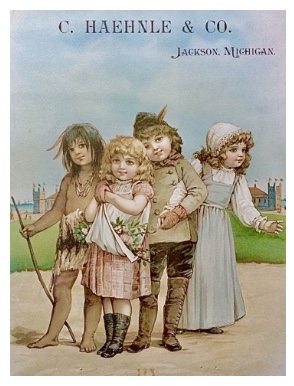|
Casper Haehnle I.
Johannes Caspar Hähnle, being 30 years
old was among the emigrants of this year. His father Bartholomäus Hähnle had inherited the inn „Ochsen“ from his
father and had married the youngest daughter of the innkeeper of the „Krone“. Seven of his siblings died as babies.
When Caspar was aged 12, his father sold the parental inn „Ochsen“ and bought the inn „Kanne“. Two
years later, his oldest sister married Johann Georg Wulz, a master builder. He may have had a first contact with America.
His brother-in-law Johann Friedrich Martin, city treasurer of Giengen, flew from penalty to Pittsburg because of anomalies
in the finances of the city. Wulz himself died in an accident at work a few years after his marriage. Caspar’s sister,
now widowed, married Friedrich Steiff from Geislingen, also a masterbuilder. These two are the parents of Margarete Steiff,
founder of the famous toy-factory, who was born 1847. Another
sister of Caspar was married with Johann Jakob Hähnle as his third wife. So she became the stepmother of Hans Haehnle, founder
of the felt industry and councilor of commerce.
In 1848 Caspar Hähnle married Anna Barbara
Hodum, widow of Simon Schuholz, a canvas manufacturer. He died in the age of 22, so he had run the parental manufactory with
40-60 hand-looms just a few years. The young widow brought along a baby, just a few months old. In the next five years five
children were born, but two of them died as a suckling. These
was exactly the very bad times mentioned above. Brewers experienced that as well as innkeepers. Sons and daughters from nine
of the fifteen innkeeper-families emigrated. Sylvester Hähnle, Caspars older brother, went to America with the son of the
“Ochsen”-innkeeper in July 1852. In this year Caspar rented the inn “Hirsch”, opposite of the parental
“Kanne”, for a yearly payment of 67 florin. Two years later his whole assets were dissaved and he announced his
insolvency. The inn “Kanne” was sold by auction to the “Stiftsverwaltung”, because this institution
was creditor for more than 4,500 florin. Caspars
decision to queue among these emigrants, who want
to leave city and country in search of a new home across the ocean and, as they hope, to gain a better existence, was surely not an easy one. His youngest daughter was just born in June
and the other two children were very young. Certainly it was planned that his wife and children could follow him later. So Caspar’s wife gave her officially demanded agreement
in August 1854: The undersigned wife of Caspar Hähnle
declares hereby not only her compliance with the voyage of her husband to Nothern America, she also is about to give the required
money for this journey to him, which she will take out of the capital of her son Schuholz (studiosus), who shall get it back
annually. Hähnle could engage the agency Chrystie Heinrich & Comp.,
whose agent in Ulm was recommended in Giengen. This “travel agency” was specialized on the route Le Havre –
New York with post ships and their service was widespread. Conductors accompanied the emigrants till boarding the ship, so
they never felt lost. The agent pointed out the comfortable interior of the ships, which promised an agreeable voyage.
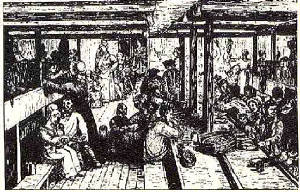
|
| In the Steerage of an emigration ship |
The charge included the following: a) free voyage from Mannheim to New York; b) a place in the steerage of the post ships; c) free transport of the baggage the things for personal
use during the voyage; d) a bedplace and pharmacy, if necessary; e) a space in the kitchen for cooking; f) enough fresh water, wood and light, and the passenger is g) freed of head money at the arrival
in America; h) additional
the departure at the day determined in the contract is assured. If there would be a delay, a daily compensation money of 42
Kreuzer or 1 ½ Francs for each adult, respectively 28 Kreuzer or 1 Francs for each child from 1 to 10 years; i) the correct delivery of his baggage
in Le Havre, after an advance payment of 1 % of the declared value. The regulated victuals for the voyage to New York consists in 40 lb zwieback, 5 lb rice, 5 lb
flour, 4 lb butter, 14 lb ham, gammon or smoked meat, 2 lb salt, 2 l vinegar and 140 lb potatoes or 30 lb legumes. This may
be brought by the passenger himself or could become part of the contract. In this case Chrystie Heinrich & Comp. will
deliver the victuals in best quality in Havre. Every passenger has free baggage: 2 centner for adults and 1 centner for children; generally it is recommended to
the passengers not to carry along too much baggage or useless artifacts.
Monthly three
post ships sailed to New York. The voyage took about 30-35 days. The crossing of the ocean was often stormy and a lot of the
passengers got seasick. The conditions in the steerage of a emigrant-vessel was described by Friedrich Gerstäcker, a very
popular writer, in a letter to his mother: Imagine
a room about 11 footsteps long, 9 footsteps wide, 8 footsteps high, with beddings or berths at both sides, always two being
on top of each other, nailed with two planks, with 10 persons in each berth, 5 on top and 5 under it, ... Now imagine this
room under bad weather with 100 and more emigrants locked into, imagine their evaporation, the laughing, bluster, vomit, lamenting,
shouting of the children etc. etc. and you have a proper image of this room! In the steerage of an emigration ship
Most of the
ships arrived in New York. The immigrants preferred this city, because they hoped to find fellow countrymen or relatives there.
Another reason was the good transport connection to the West. They could board a steamboat in New York and go up the Hudson
River to Albany. The Erie-channel was completed in 1825, so the immigrants could reach Buffalo on Lake Erie nine days later.
It looks rather possible, that Caspar Hähnle took the same way onward to Detroit.
It was around 1850 that the United States of America completed it’s territorial expansion form the 13 States in the
East to the Pacific coast in West, partly with money, partly with war. Now colonization began in the areas inhabited by Indians.
Gold was discovered in California in 1848. In 1860 anti-slavery lawyer Abraham Lincoln was just elected president, when eleven
southern
states seceded from the Union (1861). In the now following Civil-War about 600,000 people were killed in the following four
years.
Casper Haehnle, as he wrote himself now, was merely employed as a wage earner in Detroit. It seems
that he had given up his original intent of catching up his family to America in these years. If it were the circumstances
in the new home or if it were other reasons, we would never know. His family back in Giengen alleged now that he left them with bad intent. His wife filed a petition for divorce.
The royal county court in Ellwangen declared the marriage as divorced as requested from the wife, because her husband, now living in Detroit in the north American State Michigan,
abandoned her with criminal intention.
About 1864 Casper I. married again a widow with children. His
wife Amelia Baltz, born Mauch, was also born in Germany. In the next years the new family moved westwards into Michigan.
They settled in Jackson, a county capital right between Detroit and Chicago. He embarked in the brewing business here
in Jackson, founding the “Casper Haehnle” brewery. But they soon removed to Marshall, in Calhoun county next to
Jackson, where he followed the brewing business again. In 1867 his homonymous son Johann Caspar arrived here from Giengen and lived with his new family. But already in 1869 Casper
Haehnle I died at the age of only 44 years.
Casper Haehnle II.
Right after his confirmation, the fourteen
year old son Johann Casper Haehnle tried to get the allowance to quit the citizenship of Wuerttemberg. He wanted to
emigrate to his father in Northern America.
Because he stood under guardianship, it was necessary to get the
admittance of his guardian and the orphan’s court. For hedging possible claims a guarantor was to be named. Caspar found
his uncle Friedrich Steiff for this. In January 1868
the district office in Heidenheim had nothing more to argue against his emigration.
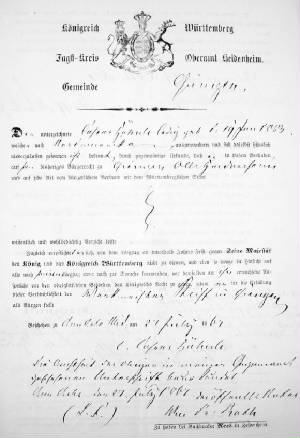
|
| The release from citizenship in 1868 |
The young Casper, now spelled with an ‘e’, got now into a new family. He could be
just a short time together with his father, whom he could not remember since he was just too young when his father left Giengen.
In one of the years after the death of Casper I. in 1869 the rest of the family moved to Blackman in the suburbs of Jackson.
Casper Haehnle II., now called ‘Cap’, married his stepsister Mary Baltz on December 9, 1875. She was
the daughter of his stepmother Amelia Baltz and Frederick Baltz, both born in Germany. Mary’s father had died when she
was four years old and her mother had become the second wife of Casper Haehnle I.. The result is a somewhat unusual complication:
the wife of Casper Haehnle II. was a daughter of the wife of the father of her husband.
In Jackson Cap II. had admitted new partners into the brewery and they called it now “C. Haehnle & Company”.
He successfully conducted the enterprise until his death in 1893.
The young family increased with
the children Casper III., born 1876, and Amelia, born 1878. In the big house there was not only the family residing, but also
a house keeper and four labourers, all of them being of German descent. Cap Haehnle II. was a man of marked energy and enthusiasm, and the possessor of much enterprise and public spirit.
He was a kind hearted man, affable in manner, and known widely as a friend of the working man, often being known to provide
work for men in his plant when there was really no need for their services, so that regardless of the times, his plant always
ran at capacity. He was a member of the ‘Arbeiter-Verein’ and of the ‘Harmonic Society’, both German
in their nature.

|
| Relationship between the families Haehnle and Steiff in Giengen |
It was November 29, 1889, when the advancement of the Haehnle-Brewery got a hard relapse. A fire destroyed most
of the buildings. The following excerpt from „The Jackson Weekly Citizen“ gives a good idea what happened:
The extensive brewing plant of Casper Haehnle, two miles north of Main Street, on Cooper street,
north of the city limits was burned Friday morning between the hours of 2 and 4 o’clock. The first notice of the fire
in the vicinity of its location was about 2 a.m. by a guest at the residence of Mr. Haehnle, who was awakened by the light
from it shining in at his window. He at once aroused the household, and an alarm was telephoned in to the department, which
responded as fast as it was able, the condition of the roads making the trip to the brewery a slow and hard one, the last
quarter of a mile being up a steep hill. The plant is beyond the reach of water supply, but some years ago the proprietor
had constructed an artificial pond from which he gathers his ice in the winter, and this pond water and the steamer did all
that was possible under the circumstances. It was 9 o’clock this morning before the fire department reduced the fire to control and put it out. At that
time the extensive plant which had been the pride of Mr. Haehnle, was little more than a ruin. The fire which was first discovered
in the west end of the brick building, was carried through the entire works, and its headway was such before the arrival of
the department that the whole interior was destroyed. The department succeeded in saving the wooden building at the east and
north, which is used as an ice house, and part of the brick east wing, but all the machinery and the entire western portion
with the cellar and its contents, also 3,000 bushels of malt were reduced to a smoking worthless mass.
A representative of The Citizen was at the scene this morning at an early hour, and in a personal
interview Mr. Haehnle said, I cant say how the fire started. Its a mystery to me. There was no fire in or about the engine
room, nor had there been for two or three days. There are men who slept in the west part, and they had a stove, and there
was also a stove in the southeast part of the works and I presume there was a fire in that also, but I am not sure. I cant
see how the fire would be likely to catch from either place and it may not have done so. There are a great number of tramps
about here and they may have caused it. All is a guess with me. What was your plant valued at Mr. Haehnle? Oh, I think between
$50,000 and $60,000. My insurance is $20,000 on the building and contents. Will you build here again or elsewhere? Here, sure.
I have nothing else to do. My home is here, all my property is here and I shall go ahead again as soon as I can get things
straightened out.
During the
forenoon Mr. Haehnle placed some of his men at work removing the debris and remarked he had not so many employees as usual
to lay idle. The insurance companies will have an appraiser here at once and the matter of the loss will be agreed upon. A
great number of Mr. Haehnles friends called to see him during the day and tendered him any service they might need, financial
or otherwise, to build again, but it is safe to say that financially he needs no ones assistance. He will for the time being,
use the old brewery plant on Lansing Avenue, where at present he has a quantity of material in storage, so that suffering
a few days loss of time he will be in the market again, and he believes that of the 2,000 barrels of beer on hand, 1,000 is
fit for use.
The new brewery was built with great expense and in every detail
modern. Cap II. could really expect great success in the future.
Apparently the burning of the brewery hurt himself too, because he died not long after, on February
10, 1893. He was just 40 years of age. His passing was widely deplored in and about Jackson, and a host of people mourned
his loss.
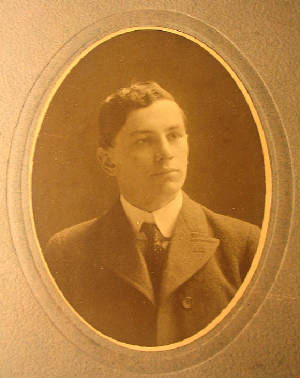
Casper Haehnle III.
The third Haehnle named Casper was born
in Jackson in 1876. He was but a youth of sixteen years when his father died, and he attended to its every detail during the
first two years before he became old enough to become manager and take charge of the brewery.
The
brewery was renamed in “Haehnle Brewing Company” and Casper III. was but eighteen years when he took charge of
the outside management, Mrs. Berger has maintained complete charge of the books and of the office work. After being married
to Nelly Meyfarth, their only child, daughter Phyllis, was born.
Beneath managing the Haehnle brewery Cap III. expanded his activities.
In 1901 he joined the “Superior Brewery” in Ironwood, Michigan. In the far northwest of Michigan were found great
deposits of iron ore and mining started soon after. The new founded city Ironwood was growing fast and the workers wanted
to drink fresh beer. The brewery was now renamed “Ironwood Brewery”.
Prohibition in Michigan stopped bee production in 1918. Fabrication
and distribution of alcohol was illegal until 1933. the aim was the reduction of poverty, mortality and crime as well as increase
of economy and quality of life. Instead of that prohibition claimed the increase of the crime rate and consume of alcohol. The brewery was renamed in „Haehnle Products Co.“
and produced now nonalcoholic drinks and beers.
As an additional branch the manufactoring of ice was forced. His
father had already made ice for many years for the distribution of the beer. it was needed for long distance transports of
al kinds of food. So the „City Consumers Ice Co.“ was founded an the ice was called “Haehnle’s
Hygenic Ice”.Cap III. manufactured around 3,500 tons of it every year. It was distributed locally and had an Ice storage
shed at Devil’s Lake of some 4 acres. They also shipped hundreds of tons of it for the fishing industry at the Gulf Coast and had a yearly output of $178,000.00.

|
| The RMS Majestic |
History of the RMS Majestic
History of the Majestic
In late summer 1922 Casper III. made a trip of his own to Europe. Perhaps he visited Giengen, his father’s
birthplace. For the voyage back to America he boarded the RMS “Majestic”. At that time it was the largest ship
of the world and had been just completed a few months ago.
After prohibition had been abolished
in Kanada in 1925, Cap III. founded there a vinery directly opposite of Detroit, called „Windsor Wine Co. of Walkerville,
Ontario“. Later it was removed westerly of Detroit and renamed „LaSalle Wine & Champagne Co. of Farmington“.
The beer production started in Jackson again after the end of prohibition in USA in 1933. The
beer was now also sold under the label „Old Hill-Top“, because the brewery was located on top of the highest elevation
in Jackson. The Hill where the brewery was located was referred to and is still referred to as “Haehnle Hill.”
One year later the brewery was rented to am man called Tucker North. He ran it further under the name Haehnle
Brewing Company for just tree years until it folded up in 1937.
Meanwhile Cap Haehnle III opened a new brewery in Battle Creek, Michigan, named “Silver Foam Brewing Co.”.
Later he gave this brewery also out of his hands and sold it to a relative name Bill Honer.When
Cap III. was in his seventies and his only daughter Phyllis had been married to James F. Clancy for many years, he retired
from business. So in 1946 he sold some equipment and distributorship rights for Stroh Brewery, Detroit, in the local area.
Stroh was the largest brewery in Michigan at that time und when the family Stroh sold their activities in 1999, it was claimed
the fourth biggest brewery in the USA.
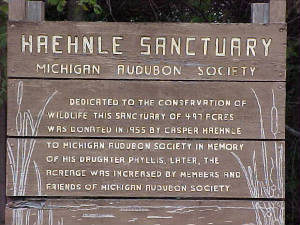
After retiring Casper spent his time in nature and was attended to his estates, which he had bought during his life.
This was mostly marshland along the Portage River. In the 30’s and 40’s he was hunting there and he began to like
the landscape. Members of the Audubon Society, Michigan’s oldest conservation organization, noticed the potential of
the Mud Lake Marsh. They listed 138 species of birds, including Yellow Rail, Greater Prairie Chicken, and nesting Great Blue
Herons. By the mid-forties, Cap Haehnle III.
wasn’t hunting as much as he used too. About this time Harold Wing, a member of the Audubon Society, approached Cap
Haehnle about making the Mud Lake Marsh into a Audubon Sanctuary. At first, Cap Haehnle was uncertain about whether Michigan
Audubon Society could keep Mud Lake Marsh as a Nature Sanctuary. But on January 22, 1955, after many visits by Harold Wing
(accompanied by other Michigan Audubon members) convinced him of Michigan Audubon’s commitment, Cap Haehnle gave the
Michigan Audubon Society 497 acres, including Mud Lake Marsh. The Phyllis Haehnle Memorial Sanctuary is named after Haehnle’s
only daughter, Phyllis Haehnle Clancy, who died in 1950. Since Cap Haehnle’s original gift of 497 acres, gifts from
Cap’s granddaughter, Judy Cory, and purchases by the Michigan Audubon Society have enlarged the sanctuary to over 900
acres. The sanctuary is owned by the Michigan Audubon Society and managed by the Jackson Audubon Society.
Casper Haehnle III. died in 1955 at the age of 82. Descendants of his brother Benedict Haehnle still live in Michigan. Sources:
Archive of the protestant church in Giengen Archive of the city of Giengen “Heimatbuch des Kreises Heidenheim” Personal notes from Gregg und Todd Haehnle U.S. Census 1880 Passenger list of “RMS Majestic” Michigan Breweriana Online Michigan Audubon Society
| Export Beer |

|
A vintage Peninsular Brewery advertisement from the late 1800s. One of the earliest advertisements from Casper Haehnle 1.
There is an old trade card with the same verbage.
|
